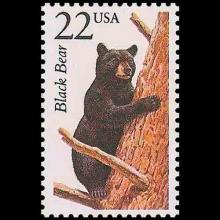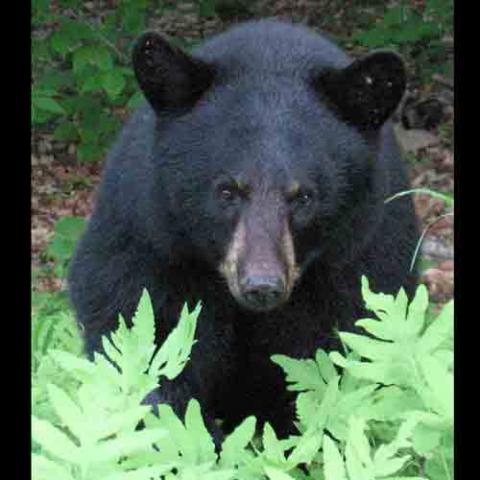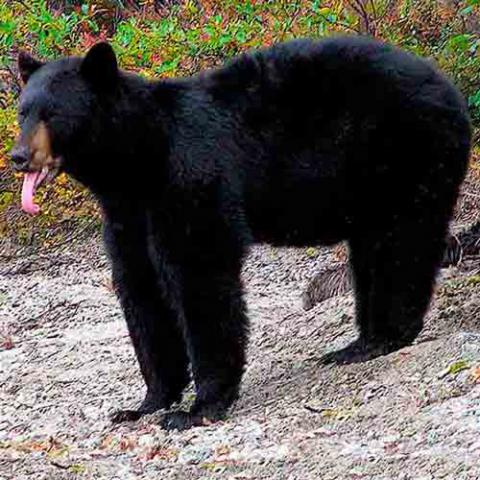NAMES
TAXONOMY
United States
Issued:
Stamp:
Ursus americanus
United States
Issued:
Stamp:
Ursus americanus
United States
Issued:
Stamp:
Ursus americanus
One May morning, when I was living on the Shawangunk Mountains, I looked out my bathroom window and was quite surprised to see three black bears foraging. I quickly fetched my camera and captured this short video clip of what seems like two adults and one cub. A few months later, one (or more) came back to visit. The bird feeder that was hung up in the front yard was pulled down and emptied. I don't think it was the handiwork a squirrel, because the metal carabiner clip was pried open and the metal parts of the feeder were all bent out of shape. My neighbor later told me that bird seed is bear candy.
Genus species (Animalia): Ursus americanus
American black bears are omnivorous and opportunistic. Food habits are influenced by season, food abundance and accessibility, human activities near American black bear habitat, and reproductive status. In general, grasses and forbs are preferred during spring; soft mast (typically berries) and insects are preferred during summer; and hard mast such as acorns and other nuts dominates the fall diet.
Grasses and herbaceous plants
Due to a poor ability to digest cellulose in mature plants, American black bears consume young, green vegetation, primarily during spring. In Yukon, Canada and the Yukon-Tanana uplands of interior Alaska, horsetail (Equisetum spp.) is important during spring and summer, comprising up to 86% of American black bear diets. Apical meristems of saw-palmetto are an important part of Florida black bear diets, and cabbage palmetto (Sabal palmetto) dominates the spring diet.
Insects
Insects obtained from coarse woody debris are important food items, primarily during summer. In northeastern Oregon, Bull and others reported higher frequencies of insect consumption than elsewhere in the United States. High consumption of insects may have been related to a shortage of other foods. Total frequency of insect occurrence in 621 American black bear scats collected between April and October over 2 years was 70%. During July of one year, total frequency of occurrence was 98%. Insects eaten included carpenter ants (Camponotus spp.), forest ants (Formica spp.), other ants (Lasius spp., Tapinoma spp., and Aphaenogaster spp.), and yellowjackets (Vespula spp. and Dolichovespula spp.). In the Greater Yellowstone ecosystem, army cutworm moths (Euxoa auxiliaris) are eaten during summer months. Feeding sites are located on scree slopes at high elevations (x=11,010 feet (3,356 m)), with alpine tundra-covered benches and plateaus above and below feeding sites.
Soft mast
The most common soft mast eaten by American black bears are berries produced by shrubs. Some of the more important masting species include blueberries (Vaccinium spp.), huckleberries (Vaccinium spp.), blackberries (Rubus spp.), serviceberries (Amelanchier spp.), strawberries (Fragaria spp.), autumn-olive (Elaeagnus umbellata), and russet buffaloberry (Shepherdia canadensis). Saw-palmetto fruits are an important year-round food item for Florida black bears. For a list of native fleshy fruits eaten by American black bears across their range, see Wilson.
Hard mast
Hard mast is important for American black bears in all geographic regions except the Pacific Northwest and is generally more abundant in eastern portions of the American black bear's range. American black bears may travel long distances during fall looking for hard mast and may climb up to 98 feet (30 m) in trees to forage. Hard mast eaten by American black bears may include acorns, hickory (Carya spp.) nuts, beechnuts (Fagus spp.), whitebark pine (Pinus albicaulis) seeds, limber pine (P. flexilis) seeds, and pinyon (Pinus spp.) seeds. Acorns preferred by American black bears include those of Gambel oak in ponderosa pine habitat in the Rocky Mountains, red oak and white oak in central hardwood forests, and Oregon white oak in the northwestern United States and southwestern Canada. Production of acorns is often episodic and synchronous, so acorns may not be a reliable food source. Whitebark pine seeds are a high-quality food for American black bears due to their high digestibility, relatively large size, and high fat content. Consumption of whitebark pine seeds occurs primarily south of the western US-Canada border. Use is greater in continental climates (18.7%) in the northern and central Rockies than in maritime climates (2.7%) in the northwestern United States. Within the Greater Yellowstone Area, American black bear consumption of whitebark pine seeds is greatest in mature stands (>100 years old).
Whitebark pine seeds are eaten primarily during fall. American black bears may also raid red squirrel (Tamiasciurus hudsonicus) whitebark pine seed caches during spring. Whitebark pine cone production may vary widely based on site, individual trees, years, and white pine blister-rust infection. In Yellowstone National Park, large cone crops usually occur every 4 to 9 years. Seed consumption may vary considerably among years, depending on crop size. Heavy consumption of whitebark pine seeds occurs when crops average >13 to 23 cones/tree. American black bears may eat seeds up to 1 year after crop production.
In the Rocky Mountains, limber pine seeds may be an important food for American black bears when other foods are limited, and pinyon seeds are eaten in the Great Basin and southwestern United States.
Vertebrates
American black bears are more likely to eat carrion than to capture live prey; however, they are capable of killing vertebrates. Vertebrate carrion or prey items include woodland caribou (Rangifer tarandus caribou), elk (Cervis canadensis), white-tailed deer (Odocoileus virginianus), mule deer (O. hemionus), and moose (Alces alces). Other vertebrates eaten by American black bears include Mount Graham red squirrels (Tamiasciurus hudsonicus grahamensis), sooty grouse (Dendragapus fuliginosus), bird eggs, and salmon (Oncorhynus spp.). Florida black bears may eat nine-banded armadillos (Dasypus novemcinctus) and feral pigs (Sus scrofa).
Other
Stems and leaves of quaking aspen, poplar (Populus spp.) catkins, and black cottonwood buds are eaten during spring. When wild foods are scarce, American black bears may occasionally prey on domestic sheep, goats, pigs, and young cattle. They may also eat garbage, agricultural crops, and orchard fruits.
For information on forage preferences and palatability ratings of American black bears in various phases within the grand fir/Rocky Mountain maple (Acer glabrum) habitat type and the Douglas-fir/white spirea (Spiraea betulifolia) habitat types in Idaho, see Steele and Geier-Hayes. For a list of foods eaten by American black bears by season in lodgepole pine (Pinus contorta) and mixed deciduous-coniferous forest in Kananaskis Country, Alberta, see Holcroft and Herrero.
Predators
Other than humans, American black bears have few predators except grizzly bears, mountain lions (Puma concolor), and gray wolves (Canis lupus). Male and female American black bears may kill and eat each other. American black bears of either sex can benefit from cannibalism; however, cannibalism is probably most common in large males. Cannibalism by nonkin American black bears may serve several purposes: for food and to reduce competition for other food resources, space, and mates.
Reference: US Forest Service - National Park Service
Video: Peter Needle



